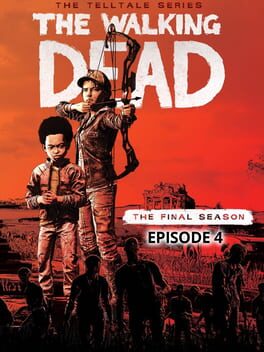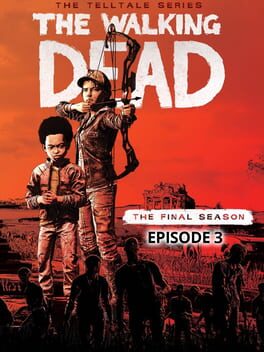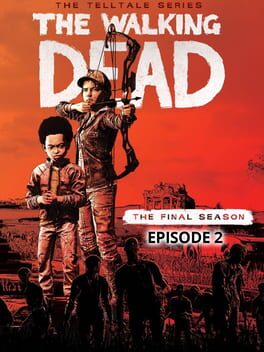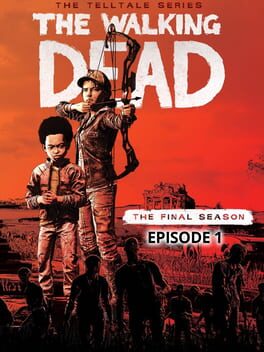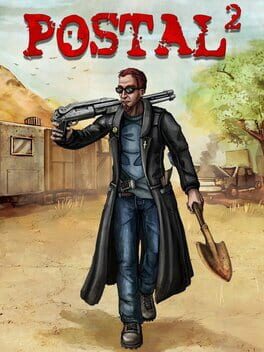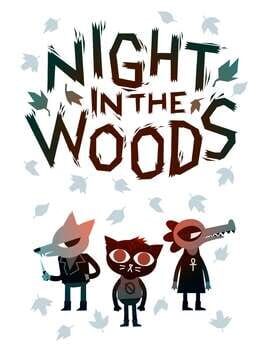TheAmega
Mark Twain once said, "History doesn’t repeat itself, but it often rhymes." That could be the theme of the fourth and final season of Telltale's Walking Dead series. The callbacks to previous seasons, especially the parallels between this season and the first one, are too numerous to count. They say imitation is the sincerest form of flattery, but much like the relationship between The Force Awakens and A New Hope, that flattery doesn't always stick the landing.
The Final Season is spread across four episodes. Those episodes are of varied quality, but most are generally quite good. The overarching theme is Clementine's efforts to mould AJ into the survivor he needs to be. As a parent, I can relate to that challenge, even if I'm not actively preparing my children to survive a zombie apocalypse...yet. This mirrors the first season, where Lee is tasked with doing the same thing for Clem. The dynamic between Clem and AJ is probably the most engaging part of the game as it is the best-written part and provides for the bulk of the meaningful choices that this series is known for.
Clem and AJ start their journey alone but quickly end up joining a band of rag-tag children occupying the boarding school they once attended. These children make up the bulk of the supporting cast and offer some variety, even though they aren't nearly as interesting or well-written as Clem and AJ. The cast is rounded out by the villains, a group of raiders from a neighbouring community with their sights set on the school's occupants. The big bad, too, is another callback, and their place in the narrative does make some sense.
Visually, the game is an iterative improvement over the previous seasons. Some care and attention have been placed on the graphical fidelity and trying to match the game's art style more closely with the comics. However, Telltale's famous janky animations have not been improved, for better or worse.
Sound is nothing to write home about, but it does what it should. Most of the characters are well-acted and believable, but the sound effects aren't anything special. There's been no dramatic improvements in impact since the first season. The music is quite good, with a few decent pieces used to add emotional weight to scenes.
The most significant changes have occurred in gameplay. The play style is now less point-and-click and more over-the-shoulder—more Gears of War than Monkey Island, if you will. This makes the action more frenetic, but it can be a little jarring going from the other seasons to this one. Once I was used to it, I found it made the game feel more modern. I liked that, but it may not be to everyone's taste.
Finally, I need to talk about the ending. I'll avoid spoilers as much as possible. As I said in my final episode review, the ending didn't land with me. I get why they chose that ending, and I'm not unhappy with it, but I don't think they earned it. The game sets up a real gut-punch ending as another callback to the first season and then does a complete 180, and yeah, nope, it all goes away. This creates a massive plot hole that goes completely unexplained. And then yadda yadda, here's the ending we want you to have. It just feels like the ending didn't earn the payoff, and by not closing that plot hole, they missed out on what could have been some compelling gameplay. It might have been enough for a fifth episode and would have provided a more satisfying ending.
Telltale was having issues at the time, so perhaps I'm being too critical. And almost nobody closes out a well-loved series in a way that feels satisfying to everyone. But I see a missed opportunity, and I can't help but feel a bit disappointed. It's a great game, but it could have been even better.
The Final Season is spread across four episodes. Those episodes are of varied quality, but most are generally quite good. The overarching theme is Clementine's efforts to mould AJ into the survivor he needs to be. As a parent, I can relate to that challenge, even if I'm not actively preparing my children to survive a zombie apocalypse...yet. This mirrors the first season, where Lee is tasked with doing the same thing for Clem. The dynamic between Clem and AJ is probably the most engaging part of the game as it is the best-written part and provides for the bulk of the meaningful choices that this series is known for.
Clem and AJ start their journey alone but quickly end up joining a band of rag-tag children occupying the boarding school they once attended. These children make up the bulk of the supporting cast and offer some variety, even though they aren't nearly as interesting or well-written as Clem and AJ. The cast is rounded out by the villains, a group of raiders from a neighbouring community with their sights set on the school's occupants. The big bad, too, is another callback, and their place in the narrative does make some sense.
Visually, the game is an iterative improvement over the previous seasons. Some care and attention have been placed on the graphical fidelity and trying to match the game's art style more closely with the comics. However, Telltale's famous janky animations have not been improved, for better or worse.
Sound is nothing to write home about, but it does what it should. Most of the characters are well-acted and believable, but the sound effects aren't anything special. There's been no dramatic improvements in impact since the first season. The music is quite good, with a few decent pieces used to add emotional weight to scenes.
The most significant changes have occurred in gameplay. The play style is now less point-and-click and more over-the-shoulder—more Gears of War than Monkey Island, if you will. This makes the action more frenetic, but it can be a little jarring going from the other seasons to this one. Once I was used to it, I found it made the game feel more modern. I liked that, but it may not be to everyone's taste.
Finally, I need to talk about the ending. I'll avoid spoilers as much as possible. As I said in my final episode review, the ending didn't land with me. I get why they chose that ending, and I'm not unhappy with it, but I don't think they earned it. The game sets up a real gut-punch ending as another callback to the first season and then does a complete 180, and yeah, nope, it all goes away. This creates a massive plot hole that goes completely unexplained. And then yadda yadda, here's the ending we want you to have. It just feels like the ending didn't earn the payoff, and by not closing that plot hole, they missed out on what could have been some compelling gameplay. It might have been enough for a fifth episode and would have provided a more satisfying ending.
Telltale was having issues at the time, so perhaps I'm being too critical. And almost nobody closes out a well-loved series in a way that feels satisfying to everyone. But I see a missed opportunity, and I can't help but feel a bit disappointed. It's a great game, but it could have been even better.
The final episode of the final season is another well-written episode with some good tense and exciting moments, some poignant character development, and a feeling of weightiness (whether real or imagined) to the choices you made throughout the season. It also serves as a conclusion to both the season and the series as a whole. That conclusion left me with mixed feelings. In the final act of this episode, they set you up for a gut-punch ending but don't have the stomach to follow through on it. This creates a plot hole large enough for a herd of walkers to pass through, but on some level, I get why they chose to end the series that way. It just feels like the ending didn't earn its payoff, and by not closing that plot hole, they missed out on what could have been some compelling gameplay. It might have been enough for a fifth episode and would have provided a more satisfying ending. TellTale was having issues then, so perhaps I'm being too critical. And almost nobody closes out a well-loved series in a way that feels satisfying to everyone. I see a missed opportunity, and I can't help but feel a bit disappointed. It's good for what it is, but it could have been better.
The third episode of the final season is a slow burn for the most part. There's a long stretch of quiet character development following the action that capped off the second episode. However, this slower gameplay is well-spent, giving much-needed time for character development. The episode ends with another action-packed sequence that, while enjoyable, has some frustrating moments that rely too much on quick-time events. The episode ends with a decent confrontation between Clementine and the big bad, marred by how cliche it was. This has been my favourite episode so far this season, but it still doesn't rise to some of the really great episodes from earlier seasons.
The second episode of the final season is a bumpy ride. On one hand, it feels much more developed than the first episode, with more twists and turns, reveals, and overall plot development. On the other hand, it sometimes feels rough, as if it could have used one more edit in the writing room. The big plot points are interesting, and some are quite exciting, but the narrative that holds those plot points together doesn't stand up quite as well. It's better than the first episode of this season but isn't as good as some of the standout episodes from previous seasons.
The first episode of the Final Season season does a good job of establishing everything, which is what the first episode is supposed to do. We meet up with Clementine and AJ again. We learn about their developing relationship. We get a sense that the overarching theme for the game will be Clem's struggle to mould AJ into the best person he can be. This struggle is, of course, affected by the state of the world, forcing Clem to find a balance between being a survivor who will do anything to stay alive but won't end up like so many of The Walking Dead's villains who do so at the expense of others. The first episode also establishes the setting (a boarding school for troubled youth), the supporting cast (the troubled youths), and some initial conflict (the constant fight to find more food and the looming threat of another group of survivors). First episodes are rarely as heavy-hitting as the final ones, and this is the case here. Still, it's a satisfying start to the game.
2002
Metroid Fusion is the fourth game in the main Metroid storyline. Once again, you don the Chozo-infused armour of the galactic bounty hunter, genocide enthusiast, and all-around errand girl for a dubious space empire, Samus Aran. After returning to the planet from the second game (where she killed all but one of the Metroids), she gets infected by a different parasitic alien species, the "X," and almost dies. This all happens before you even press start at the title screen.
To save her from certain death at the hands of her X infection, a bunch of science guys inject her with an infusion of Metroid DNA that they happened to have lying around. This miraculously cures our heroine and conveniently gives her the ability to absorb X to regenerate her health and for some reason, missiles. This is convenient for two reasons. One is because the science station is quickly overrun by the X, and also because after the last Metroid died saving Samus from Mother Brain in the previous game, the developers were running out of reasons to call the series "Metroid." Although, as we all know, it would be more accurate if they renamed this series "Nothing Ever Really Dies."
Anyway, Samus ventures to the newly X-infected science station in her very weakened state. The science guys had to "surgically remove" her old suit to save her life. But don't worry, guys, she grew a new one or something. For you speedrunning hoarders out there, never fear, if you beat the game fast enough while collecting enough junk, you can still see pictures of Samus in her underwear. Joined on her journey to the obviously going-to-self-destruct-at-some-point science station is a plucky AI co-pilot who may or may not be the resurrected brain of her former commander who was conveniently retconned into the story to vomit exposition and move the game along. Remember, Adam Malkovich won't actually appear in the series for another eight years when Metroid: Other M is released.
That's probably the longest preamble I've written to date, which is a testament to how much more story they've seemingly added to the game. Although where Super Metroid communicated its story quite masterfully with atmospheric cues, Fusion beats you over the head with it at every opportunity.
From a visual perspective, Fusion is an improvement over Super Metroid. The art is more detailed and generally more readable. The animations are much smoother too, both for Samus and for the enemies she encounters. Most of it works well, although some of the more familiar bosses look more like Saturday morning cartoon versions of themselves than they probably should.
The audio is a bit of a mixed bag. The music is pretty whatever. Half the time, I didn't even realize it was there. There's nothing as notable as some of the themes used in Super Metroid. The sound effects are all over the place. Some are punchy and crisp, while others are muddled or feel out of place.
The gameplay is fine but it doesn't live up to Super Metroid. Throughout the game, the AI points you to where to go next, so you never explore the map for yourself. There's a clear path the game sets out for you and little reason to go off script. Most of the enemies are recycled from other games, although instead of dropping missiles and energy pellets, they transform into X upon defeat, which Samus can then "absorb." The bosses are all over the place. Some are quite interesting and offer a fun challenge. Others are cheesy and feel more unfair than challenging. And the final boss is a bit anti-climactic. This also leads me to bring up the SA-X. You see, the pieces of Samus' old suit that the science guys removed have T-1000ed themselves back together and become a new, more powerful X version of Samus with all of your old abilities. You're constantly told that the SA-X is hunting you through the science station, but apart from a handful of scripted encounters and one mediocre boss battle, the SA-X is very little like the "Dark Link" or "Tyrant" the game makes them out to be.
If it sounds like I have nothing good to say about Fusion, don't take me the wrong way. I enjoyed Fusion. I've played it twice now and had a good time each time. But it's not as good as it could have been, and that's a shame.
To save her from certain death at the hands of her X infection, a bunch of science guys inject her with an infusion of Metroid DNA that they happened to have lying around. This miraculously cures our heroine and conveniently gives her the ability to absorb X to regenerate her health and for some reason, missiles. This is convenient for two reasons. One is because the science station is quickly overrun by the X, and also because after the last Metroid died saving Samus from Mother Brain in the previous game, the developers were running out of reasons to call the series "Metroid." Although, as we all know, it would be more accurate if they renamed this series "Nothing Ever Really Dies."
Anyway, Samus ventures to the newly X-infected science station in her very weakened state. The science guys had to "surgically remove" her old suit to save her life. But don't worry, guys, she grew a new one or something. For you speedrunning hoarders out there, never fear, if you beat the game fast enough while collecting enough junk, you can still see pictures of Samus in her underwear. Joined on her journey to the obviously going-to-self-destruct-at-some-point science station is a plucky AI co-pilot who may or may not be the resurrected brain of her former commander who was conveniently retconned into the story to vomit exposition and move the game along. Remember, Adam Malkovich won't actually appear in the series for another eight years when Metroid: Other M is released.
That's probably the longest preamble I've written to date, which is a testament to how much more story they've seemingly added to the game. Although where Super Metroid communicated its story quite masterfully with atmospheric cues, Fusion beats you over the head with it at every opportunity.
From a visual perspective, Fusion is an improvement over Super Metroid. The art is more detailed and generally more readable. The animations are much smoother too, both for Samus and for the enemies she encounters. Most of it works well, although some of the more familiar bosses look more like Saturday morning cartoon versions of themselves than they probably should.
The audio is a bit of a mixed bag. The music is pretty whatever. Half the time, I didn't even realize it was there. There's nothing as notable as some of the themes used in Super Metroid. The sound effects are all over the place. Some are punchy and crisp, while others are muddled or feel out of place.
The gameplay is fine but it doesn't live up to Super Metroid. Throughout the game, the AI points you to where to go next, so you never explore the map for yourself. There's a clear path the game sets out for you and little reason to go off script. Most of the enemies are recycled from other games, although instead of dropping missiles and energy pellets, they transform into X upon defeat, which Samus can then "absorb." The bosses are all over the place. Some are quite interesting and offer a fun challenge. Others are cheesy and feel more unfair than challenging. And the final boss is a bit anti-climactic. This also leads me to bring up the SA-X. You see, the pieces of Samus' old suit that the science guys removed have T-1000ed themselves back together and become a new, more powerful X version of Samus with all of your old abilities. You're constantly told that the SA-X is hunting you through the science station, but apart from a handful of scripted encounters and one mediocre boss battle, the SA-X is very little like the "Dark Link" or "Tyrant" the game makes them out to be.
If it sounds like I have nothing good to say about Fusion, don't take me the wrong way. I enjoyed Fusion. I've played it twice now and had a good time each time. But it's not as good as it could have been, and that's a shame.
I've never been a big Castlevania fan. The series has never grabbed me like it does with other people. But I've heard, over and over, that if you play one Castlevania game, you must play Symphony of the Night. So I played it, and it was good, I guess. Not great, but decent. The game takes great advantage of the Playstation hardware, the environments are vibrant, and the characters are detailed (for pixels) and well-animated. Most of the enemies are interesting, although most don't present too much of a challenge that can't be overcome by spamming attacks at them. Having just finished Super Metroid, I must admit the level design really let me down. Although SotN is considered the reason "vanina" is in "Metroidvania," it's clear that Super Metroid is the attentive, doting mother, and SotN is the deadbeat father. There's almost no comparison. In Super Metroid, I rarely got lost to the point where I couldn't find my own way back to the critical path. SotN was the opposite. I grew tired of stumbling around whacking at walls, hoping for secret items that would allow me to progress, and eventually, I gave up and kept the walkthrough open on my phone. The upside-down 2nd half of the game (sorry for spoiling a 27-year-old game) was a neat idea, but inverting the map didn't improve its overall design. And the aforementioned walkthrough led me to acquire the Crissaegrim a lot earlier than was probably intended, making the latter half of the game mostly a joke. Imagine if Super Metroid gave you the Hyper Beam halfway through the game instead of right at the end. SotN has piqued my interest enough that I will try a few more entries from the Castlevania franchise, but it did not live up to the almost thirty years of hype I experienced before playing it.
1994
There's a reason all the Metroid games after this one feel like they're paying homage to it. Super Metroid is the series' high point. It took the concept of the NES and GameBoy versions, dialled it up as much as the SNES would allow, and the result is a stellar game, even by today's standards. The atmosphere and emotion they conveyed using only 16-bit graphics must be experienced to be fully understood. The controls are tight and responsive, the level design is masterful and the game is just fun. My only gripe, and it's a minor one, is that the quality-of-life improvements added in later iterations are missed in this one.
2001
There were two things I did not expect from Pikmin. First, I didn't think playing an RTS with a controller would be a viable option. Second, I didn't expect I would ever enjoy doing it. I'm glad I was proven wrong on both counts.
Pikmin follows a spaceman who crashes on an alien planet (presumably a future Earth) and has thirty days to recover thirty missing pieces of his spaceship and return home. To accomplish this task, the player is given control of these tiny, omnivorous, plant-based monsters called Pikmin.
The Pikmin come in three varieties, each with unique abilities and weaknesses. They are loosely classified as grunts, specialists, and marines.
Finding all of the scattered ship pieces requires using the Pikmin's abilities to overcome enemies and puzzles and then carry the parts back to your ship. The gameplay loop is simplistic but fun and rewarding. However, it appeared that most parts only had one way to collect them. I can't see a lot of replay value here unless you really like beating your previous score.
The one area that I found lacking was the interface. It's tough to figure out where you are aiming your Pikmin (you often have to throw them), and getting them to hit things in the air presents an unnecessary challenge.
If you're a fan of RTS games or drafting tiny monsters into a colourful army bent on becoming the apex predator species, you cannot go wrong with Pikmin.
Pikmin follows a spaceman who crashes on an alien planet (presumably a future Earth) and has thirty days to recover thirty missing pieces of his spaceship and return home. To accomplish this task, the player is given control of these tiny, omnivorous, plant-based monsters called Pikmin.
The Pikmin come in three varieties, each with unique abilities and weaknesses. They are loosely classified as grunts, specialists, and marines.
Finding all of the scattered ship pieces requires using the Pikmin's abilities to overcome enemies and puzzles and then carry the parts back to your ship. The gameplay loop is simplistic but fun and rewarding. However, it appeared that most parts only had one way to collect them. I can't see a lot of replay value here unless you really like beating your previous score.
The one area that I found lacking was the interface. It's tough to figure out where you are aiming your Pikmin (you often have to throw them), and getting them to hit things in the air presents an unnecessary challenge.
If you're a fan of RTS games or drafting tiny monsters into a colourful army bent on becoming the apex predator species, you cannot go wrong with Pikmin.
I liked Postal 2: Apocalypse Weekend because of its linearity, which many people seem to dislike. Something resembling a story held everything together, and the set pieces were more unique than what was on offer in the base game.
The game still has you running around doing "errands," but this time, getting milk and buying a Christmas tree are replaced with eradicating a heard of mad cows while fending off nock-off PETA activists and infiltrating a military base to acquire a nuclear warhead to set off at a rival game company's headquarters. The over-the-top nature of everything fits the style of the game much better.
The gameplay doesn't change much from the base game, and it's still one of the weakest parts. The gunplay is atrocious by today's standards; thankfully, the melee weapons are pretty viable.
Overall, if you have Postal 2, this DLC is worth getting to go along with it.
The game still has you running around doing "errands," but this time, getting milk and buying a Christmas tree are replaced with eradicating a heard of mad cows while fending off nock-off PETA activists and infiltrating a military base to acquire a nuclear warhead to set off at a rival game company's headquarters. The over-the-top nature of everything fits the style of the game much better.
The gameplay doesn't change much from the base game, and it's still one of the weakest parts. The gunplay is atrocious by today's standards; thankfully, the melee weapons are pretty viable.
Overall, if you have Postal 2, this DLC is worth getting to go along with it.
2003
Postal 2 feels like an old shooter. The references are old (member Bin Laden, member video game protestors?), the mechanics are old (no reloading in a shooter?), the graphics are old (Halo 2 and Doom 3 came out the same year), and the humour feels old.
The game is a slog. You run errands around an "open world" with more loading zones than fun. The game takes place over five instances of the same map, one for each day of the week. And it gets very repetitive. Some errands give you creative ways to solve them, mostly destroying things and killing many people. And, what little entertainment I squeezed out of this game came that. But I didn't enjoy the game enough to play it more than once.
Moreover, the game is very buggy, and I experienced several random crashes to desktop while playing.
They were trying to make a super edgy game that would serve as a middle finger to all the pearl-clutching activists in the late '90s who thought video games were corrupting the youth. But this comes off more cringe than edgy. In 2003, I probably would have loved this game, but that was over twenty years ago.
The game is a slog. You run errands around an "open world" with more loading zones than fun. The game takes place over five instances of the same map, one for each day of the week. And it gets very repetitive. Some errands give you creative ways to solve them, mostly destroying things and killing many people. And, what little entertainment I squeezed out of this game came that. But I didn't enjoy the game enough to play it more than once.
Moreover, the game is very buggy, and I experienced several random crashes to desktop while playing.
They were trying to make a super edgy game that would serve as a middle finger to all the pearl-clutching activists in the late '90s who thought video games were corrupting the youth. But this comes off more cringe than edgy. In 2003, I probably would have loved this game, but that was over twenty years ago.
I bought Metroid II at a garage sale a long time ago. Child Me was never able to get into it. The small screen of the GameBoy and the lack of a map made it a challenge I wasn't willing to overcome. Now, with a map (thanks internet) and a larger screen (thanks emulation), I played through the whole game. And I'm glad I did it, at least for the satisfaction of conquering a childhood foe. It's a decent Metroid game, especially for how old it is and the hardware it was running on, but it lacks much of what made later entries to the series such good games. Even more, the game is about committing Metroid genocide, but the titular enemies are disappointing. The early ones present almost no challenge, and any challenges presented by the later ones is because they've been programed with cheezy unfair advantages over the player. It's not a bad game, but it isn't a standout in the Metroid series either.
1990
I don't often play games from my childhood and come away still thoroughly impressed. From the tight controls and vibrant pixel graphics to the crisp sound design and catchy music. This is a great game, and it stands the test of time. The only thing more amazing than the game itself is that it fits on a 4MB cartridge.
Zero Mission is a well-made remake of the first NES Metroid game. Aside from the much-improved graphics (similar to the SNES Super Metroid), this new version includes welcome quality-of-life improvements over the original, such as a map and much more responsive controls, which are welcome additions. And, for the purists, once you beat the game, you'll discover that the original NES Metroid can be played from the options menu. This game is a great addition to the Metroid franchise.
2017
I got Night in the Woods for free from Epic quite a while ago and have just gotten around to playing it. The anthropomorphic animal aesthetic initially turned me off, but it grew on me. The gameplay is light and simplistic, mostly platforming and mini-games, but the game itself presents a rich and engaging narrative. The character dialogues are exceptionally well written and expressive, even without voice acting. I found myself playing more just to see what they would say next.

